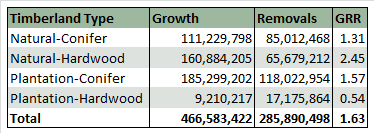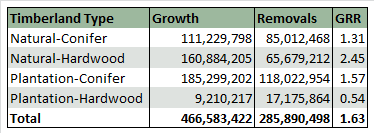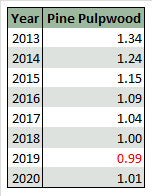2 min read
Demonstrate Wood Raw Materials are Sourced from Sustainable Forests
LeAndra Spicer : December 3, 2013

Another method for establishing wood is sourced from sustainable forests is to demonstrate sustainable supply on a biological level. Biological sustainability is measured in one of two ways: the volume of forest inventory or the growth-to-removals ratio (GRR).
Standing Forest Inventory
Inventory provides a view of the forest at a specified point in time. It reflects the volume of wood fiber that accumulates as a result of tree growth. The Forest Inventory Analysis, overseen by the US Forest Service, measures forest inventory across the country.
Once every five years, timber tracts are randomly selected throughout all forested regions in the United States. Forest Service employees inventory each plot to determine the amount of forest growth and removals, as well as any other changes that may have occurred. Forest service personnel also identify each tree by species and measure both diameter and height. Using this very exact data, FIA can assess the condition of timberland resources at a local level.
It is from this data that we know, for instance, the amount of forested land in the United States has remained stable since 1910. This data also tells us that forest resources have increased by more than 50% in the United States and 94% in the Southeast over the last 60 years.
Growth-to-Removals
Unlike the static view provided by forest inventory, growth-to-removals demonstrates the trajectory of forest inventory. A ratio of growth to removals – the biological increase in inventory compared to harvests – measures the balance between supply and demand. A GRR value of:
- 1.0 suggests that biological growth and removals are in balance.
- Greater than 1.0 suggests the forest is sustainable, and perhaps underutilized, as the growth of forest inventory outpaces removals.
- Less than 1.0 indicates removals outpace forest growth.
Over the long run, a GRR that remains below 1.0 can negatively affect forest sustainability, limit harvest opportunities and place upward pressure on wood fiber prices. Growth-to-removals for most natural wood basins in the US South are 1.0 or above.

Like any piece of data, it is important to consider GRR within the proper context. A cursory glance at one segment of data – such as the year 2019 in the table below, in which Forest2Market developed a forecast of GRR for a particular wood basin – could lead one to believe a forest is in decline.
While it is true a GRR below 1.0 indicates harvests outpace forest growth, this dip below 1.0 is simply a function of a normal, expected age-class gap.
As many landowners delayed pine sawtimber harvests during the housing crisis, regular replantings were also delayed. This created an age class gap for the years when pulpwood—had it been replanted on schedule—would have been thinned to make room for sawtimber to grow.
As sawtimber harvests pick back up, so do replantings, and the cycle reverses itself in a short span of time. Gaps like these are natural reactions to the market; they are not harbingers of deforestation or even a lack of sustainability.

Demand Changes
It is also important to consider how changes in demand brought about by factors such as competitors who enter or exit the market or the introduction of new product markets will impact the GRR of any one wood basin. GRR alone assumes no changes in demand. When forecasting GRR, scenarios for both supply (forest growth) and demand (current removals +/- changes in demand) must be modeled and applied by industry experts in order to gain an accurate picture of sustainability.





